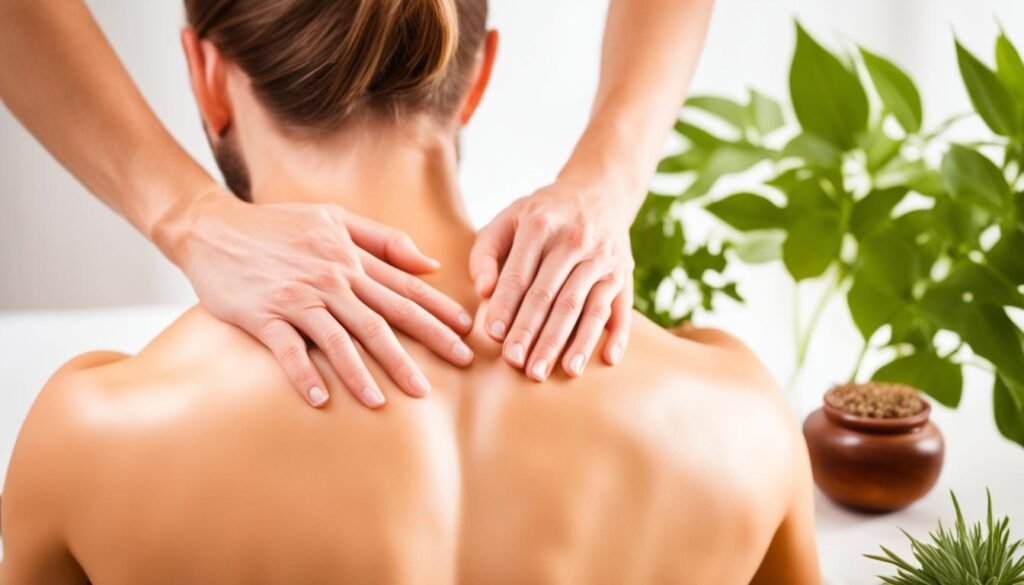If you’re dealing with back pain and muscle tension, you’re not alone. Many people use over-the-counter or prescription drugs for help. But, these can have bad side effects. Luckily, there are natural muscle relaxers that can ease back pain without harsh chemicals.
Nature has many options for easing sore muscles and easing lower back tension. Foods like cherries and blueberries are anti-inflammatory. Herbal remedies like peppermint oil and capsaicin can also help.
Magnesium is a mineral that helps with muscle contractions. It can reduce muscle inflammation and help you relax.
Changing your lifestyle can also help. Gentle stretching, yoga, and good posture can ease muscle strain. Adding these to a diet rich in nutrients and regular exercise can help you find lasting relief from back pain and muscle tension.
Key Takeaways
- Natural muscle relaxers like cherries, blueberries, and curcumin offer anti-inflammatory benefits for back pain relief
- Magnesium plays a crucial role in muscle contractions and can help reduce inflammation
- Herbal remedies such as peppermint oil, capsaicin, and CBD oil show promise as natural pain relievers
- Lifestyle changes, including gentle stretching and proper posture, can complement natural remedies for optimal results
- A holistic approach combining natural muscle relaxers, diet, and exercise can provide lasting relief from back pain and tension
Understanding Muscle Tension and Back Pain
Muscle tension and back pain can really affect our daily life. It’s important to know what causes and shows these problems. This helps us find relief and stop them from happening again.
Causes of Muscle Tightness and Spasms
Many things can make muscles tight and cause spasms, like:
- Working out too much or doing too much physical activity
- Sitting badly or not sitting right, especially for a long time
- Not drinking enough water, which can cause muscle cramps
- Lacking vitamins like magnesium and potassium
- Getting hurt from sudden moves or lifting something heavy wrong
Some health issues, like fibromyalgia, can also make muscles tight and cause back pain.
Symptoms of Muscle Tension in the Back
If your back muscles are tense, you might feel:
- Pain and stiffness in a specific area
- It’s hard to move because of reduced motion
- Spasms or muscle contractions you can’t control
- Touching the area hurts
- Pain or throbbing that gets worse when you move
| Spinal Region | Number of Vertebrae |
|---|---|
| Cervical Spine | 7 |
| Thoracic Spine | 12 |
| Lumbar Spine | 5 |
| Sacral Spine | 5 (fused) |
| Coccygeal Spine | 4 (fused) |
If you have severe or ongoing back pain, or if it spreads, you should see a doctor right away. They can figure out what’s wrong and help you.
Good posture, lifting things right, and doing exercises for your back can help prevent pain. It also keeps your spine healthy.
Knowing what causes muscle tension and back pain helps us take steps to feel better. We can stop these problems from happening again, making our lives better.
Benefits of Natural Muscle Relaxers
Natural muscle relaxers are a gentle way to ease back pain and muscle tension. They help fix the root cause of pain and aid in healing. This makes them a safe and effective choice instead of prescription drugs.
Advantages Over Prescription Medications
Natural muscle relaxants have fewer side effects than prescription drugs. They don’t lead to addiction or make you feel sleepy. These remedies work with your body to relax muscles safely.
They also fix the real reasons for muscle tightness, not just cover it up. By using things like magnesium and compounds from cherries and blueberries, you help your muscles stay healthy over time.
Holistic Approach to Pain Relief
Using natural muscle relaxers in your back pain plan helps you feel better in a complete way. They work well with other treatments like stretching, yoga, and massage.
For instance, magnesium can lower stress and help you sleep better, which is good for muscle recovery. Topical remedies like peppermint oil or capsaicin cream can ease pain right where it hurts. And, mindfulness and deep breathing can help you relax both in your mind and body.
Choosing a holistic way to manage back pain means you’re taking charge of your health. You’re not just using medicine to hide the pain. You’re using many natural ways to help your body heal and find lasting relief from muscle tension.
Cherries: Nature’s Anti-Inflammatory Powerhouse
Cherries are great for easing back pain because they have strong anti-inflammatory properties. They are full of antioxidants and compounds that lessen pain and muscle damage from exercise or daily tasks.
A 2018 review showed cherries are great for helping with exercise recovery and lessening muscle damage. Tart cherry juice is especially good for muscle recovery after hard workouts.
Cherries have lots of anti-inflammatory and antioxidant stuff in them. These help relax sore muscles and ease tension. This gives relief to those with back pain.
“I’ve found that drinking tart cherry juice before and after my workouts has made a significant difference in my muscle recovery time. The anti-inflammatory benefits are truly impressive!”
Adding cherries to your diet is easy and tasty. You can eat them fresh, frozen, or as juice or concentrate. Here are some ways to use this anti-inflammatory food:
- Snack on a handful of fresh cherries as a healthy treat
- Blend frozen cherries into your post-workout smoothie
- Sip on tart cherry juice concentrate mixed with water
- Add dried cherries to your morning oatmeal or yogurt
Studies say you can safely have up to 16 ounces of tart cherry juice or 480 milligrams of tart cherry extract capsules a day for two weeks. This is good for exercise recovery and reducing muscle damage.
| Tart Cherry Juice | Tart Cherry Extract Capsules |
|---|---|
| Up to 16 ounces per day | Up to 480 milligrams per day |
| Safe for up to 2 weeks | Safe for up to 2 weeks |
Using cherries can help your body fight muscle tension and back pain naturally. Add this anti-inflammatory food to your routine for pain relief and see the change for yourself.
Blueberries: Antioxidant-Rich Muscle Soothers
Blueberries are great for easing muscle tension naturally. They are tasty and full of antioxidants. These berries help reduce inflammation and aid in muscle recovery after exercise.
Polyphenols and Their Anti-Inflammatory Effects
Blueberries have special compounds called polyphenols. These help fight inflammation in the body. They can make muscles feel better and help with recovery.
A study showed that blueberries might improve how well you exercise and lower inflammation. This is good news for athletes and those who work out a lot.
Even though one study didn’t find much help with muscle soreness, it did show some lessening of inflammation. This is good for muscle recovery after hard workouts. Eating blueberries can give you antioxidants to fight muscle soreness and inflammation.
| Study | Participants | Findings |
|---|---|---|
| 50 randomized, placebo-controlled trials | 1089 participants (88.2% male, 11.8% female) | Small difference in muscle soreness in favor of antioxidant supplementation at different time intervals post-exercise |
| Pooled results | Varied training statuses (sedentary to moderately trained) | Standardized mean difference (SMD) in muscle soreness reduction at different time intervals post-exercise |
Incorporating Blueberries into Your Diet
It’s easy to add blueberries to your meals. They’re tasty and good for you. Here are some ideas:
- Blend them into a smoothie with your favorite protein powder and plant-based milk for a post-workout recovery drink
- Add them to your morning oatmeal or yogurt for a burst of flavor and antioxidants
- Toss them into a salad with leafy greens, nuts, and a light vinaigrette for a refreshing and nutritious meal
- Bake them into muffins or pancakes for a healthier twist on classic treats
I love adding a handful of blueberries to my morning smoothie. Not only do they taste great, but I feel like I’m giving my muscles the support they need to recover after a tough workout.
Make blueberries a part of your diet to help your muscles relax and support recovery. They’re a tasty and healthy way to fight muscle tension and inflammation. So, try adding some blueberries to your diet to feel better after exercise.
Magnesium: The Mineral for Muscle Relaxation
Magnesium is a key mineral for relaxing muscles naturally. It helps with over 300 body reactions, including muscle function. Eating foods high in magnesium can ease muscle tension and boost well-being.
Role of Magnesium in Muscle Contractions
Magnesium stops calcium from making muscles contract too much. Calcium makes muscles contract. Magnesium relaxes muscles by stopping nerves from getting too excited. This balance is key for muscles to work right.
Not having enough magnesium can cause muscle cramps and tightness. It can even lead to serious health problems over time. Getting enough magnesium helps muscles relax and stay healthy.
Magnesium-Rich Foods to Include in Your Meals
Eating foods high in magnesium helps muscle health. Good sources include:
- Leafy greens (spinach, kale, swiss chard)
- Nuts and seeds (almonds, pumpkin seeds, sunflower seeds)
- Whole grains (quinoa, brown rice, oats)
- Legumes (black beans, kidney beans, chickpeas)
- Fruits (avocado, banana, figs, raspberries)
- Dark chocolate
| Age Group | Male RDA (mg/day) | Female RDA (mg/day) |
|---|---|---|
| 14-18 years | 410 | 360 |
| 19-30 years | 400 | 310 |
| 31-50 years | 420 | 320 |
| 51+ years | 420 | 320 |
For those who need more magnesium, supplements can help. Magnesium glycinate is a good choice because it’s easy on the stomach and works well.
Magnesium is like the “off switch” for muscles, allowing them to relax and recover after contracting. Make sure you’re getting enough of this essential mineral to keep your muscles functioning at their best!
Curcumin: The Golden Spice for Muscle Relief
Curcumin, found in turmeric, is great for easing muscle pain. It’s been used for ages in traditional medicine. Now, science backs up its anti-inflammatory powers. Curcumin fights inflammation directly, helping to ease muscle tension and soreness.

Turmeric helps reduce muscle inflammation and soreness. Studies show it can ease muscle soreness after hard workouts. The Arthritis Foundation suggests taking 400 to 600 milligrams of turmeric three times a day for best results.
I’ve been using turmeric for a while, and it’s helped my muscles recover faster after hard workouts. Curcumin’s anti-inflammatory effects have changed the game for me.
When picking a curcumin supplement, look for one with piperine. Piperine helps your body absorb curcumin better. I choose a top-quality turmeric supplement with 800 mg of curcumin and a bit of piperine per serving.
| Dosage | Benefits |
|---|---|
| 400-600 mg, 3 times daily | Inflammation relief |
| 1 gram per day | Measurable anti-inflammatory effects |
| 800 mg capsules | Pain relief comparable to NSAIDs |
Curcumin is safe for most people, but pregnant or breastfeeding women should talk to a doctor before taking it. Always start with a small dose and see how your body reacts before taking more.
I also add turmeric to my food. Here are some ways I like to use it:
- Adding a teaspoon of turmeric to my morning smoothie
- Mixing turmeric, ginger, and cinnamon into a warming tea
- Sprinkling turmeric over roasted vegetables or rice dishes
Adding curcumin to my routine has helped me feel less muscle tension and inflammation. If you want a natural way to ease muscle pain and boost your athletic performance, try turmeric. It’s a golden spice that works wonders.
Natural Muscle Relaxer Back Pain: Herbal Remedies for Quick Relief
Many people are now using plant-based muscle soothers and botanical muscle relaxers for back pain. I know how bad back pain can be. That’s why I’m looking for natural ways to feel better.
There are some herbal remedies that can help with back pain and sore muscles. Let’s look at some of the best ones:
Peppermint Oil for Soothing Sore Muscles
Peppermint oil has menthol, which helps with muscle spasms. When you put it on your muscles, it feels cool. This can ease the tension and pain.
I mix a bit of peppermint oil with coconut or jojoba oil and put it on my back. It helps me relax and feel better.
Capsaicin: The Heat That Heals
Capsaicin is in cayenne pepper and helps with muscle pain. It takes away substance P, which sends pain signals to the brain. Studies say capsaicin cream can cut joint pain by half with regular use.
I mix a little cayenne pepper with carrier oil and put it on my sore muscles. It feels warm and helps with the pain.
CBD Oil: A Promising Natural Pain Reliever
CBD oil comes from hemp and cannabis plants. It’s popular for muscle pain and spasticity. It works with the body’s endocannabinoid system to manage pain and inflammation.
Many people, including me, have found relief with CBD oil. But, talk to a doctor before using it, as it can affect other medicines and cause side effects.
| Herbal Remedy | Key Benefits | How to Use |
|---|---|---|
| Peppermint Oil | Antispasmodic, cooling sensation | Mix with carrier oil and massage into muscles |
| Capsaicin | Reduces substance P, warms muscles | Mix cayenne pepper with carrier oil and apply topically |
| CBD Oil | Interacts with endocannabinoid system to reduce pain and inflammation | Use topically or take orally, consult with healthcare provider first |
Using these plant-based remedies can help with back pain and muscle spasms. Always listen to your body and see a doctor if your pain doesn’t get better or gets worse.
Lifestyle Changes to Complement Natural Muscle Relaxers
Natural muscle relaxers can help with back pain and muscle tension. But, making some lifestyle changes can make them work better. Adding gentle stretching, yoga, and ergonomic practices to your day can help a lot.
Gentle Stretching and Yoga Poses
Stretching and yoga can really help with muscle tension and flexibility. Studies show that yoga or stretching can ease low back pain. Here are some poses that can help:
- Cat-Cow Pose: Helps with spinal mobility and back muscle tension
- Child’s Pose: Stretches the lower back and hips, and helps you relax
- Seated Forward Bend: Stretches the hamstrings and lower back, making them less stiff
- Supine Twist: Helps with spinal rotation and eases back and glute tension
Always listen to your body and don’t overstretch. This can cause more harm. Slowly increase how much you stretch as you get more flexible.
Proper Posture and Ergonomics
Good posture and an ergonomic workstation are key to avoiding and managing back pain. When sitting or standing a lot, keep your spine straight and shoulders relaxed. Here are some tips:
- Get an ergonomic chair that supports your lower back and helps you sit right
- Make sure your computer screen is at eye level to avoid neck strain
- Use a standing desk or stand up and move around often
- When lifting heavy things, bend at the knees and keep your back straight
| Ergonomic Tips | Benefits |
|---|---|
| Adjust chair height | Feet flat on the floor, knees at 90-degree angle |
| Use lumbar support | Keeps the natural curve of the lower back |
| Keep objects close | Reduces reaching and twisting |
| Take breaks | Reduces muscle fatigue and improves circulation |
Nearly 63% of people reported significant improvements in low back pain after switching to a new sleep system.
Using natural muscle relaxers, stretching, yoga, and ergonomic practices can help with back pain and muscle health. Being consistent is important for seeing good results. Make these changes a regular part of your life for the best relief and prevention.
When to Seek Professional Help for Back Pain
If you have back pain that doesn’t go away after a week, you should see a doctor. If you have muscle spasms that are very bad, or if you have a fever, numbness, or weakness, you should get help right away. These could be signs of a serious problem that needs a doctor’s check-up.

About 75% to 85% of Americans have back pain at some time. Half of those with low back pain will have it again within a year. Most back pain gets better in a month with home care, but some people may have it for many months.
Some signs mean you should see a doctor right away, such as:
- Severe low back pain with incontinence, which may signify cauda equina syndrome
- Back pain accompanied by fever, possibly indicating a spinal infection
- Unexplained weight loss along with back pain, potentially signifying a serious condition like cancer
- Nighttime back pain, which may suggest infections, fractures, nerve compression, or spinal tumors
If your back pain is very bad, goes down your leg, or gets worse, you should see a doctor. They can do tests like X-rays, MRIs, blood tests, or nerve studies to find out why you have back pain. Then, they can make a plan to help you.
Don’t let chronic back pain or severe muscle spasms control your life. Seek professional help when necessary to address the root cause and find lasting relief.
Natural muscle relaxers can help with minor back pain, but they shouldn’t replace seeing a doctor when you need it. By listening to your body and getting help when you need it, you can take care of your back health. This way, you can stay active and pain-free.
Combining Natural Remedies for Optimal Results
Managing back pain and muscle tension works best with a personalized plan. We mix different natural remedies and therapies for a plan that fits us. This way, we get the best results for our needs and likes.
Eating cherries and blueberries gives us anti-inflammatory stuff. Taking magnesium helps relax muscles. Using peppermint oil, capsaicin, or CBD oil targets sore muscles.
Let’s look at some extra therapies to help:
- Acupuncture
- Acupressure
- Biofeedback
- Massage therapy
- Pain-reprocessing therapy
- Trigger point therapy
- Yoga
These therapies work well with natural remedies to heal, lessen inflammation, and ease pain. But, talk to your doctor before trying new treatments, especially if you have health issues or are pregnant.
Creating a Holistic Treatment Plan
To make a good plan for back pain relief, follow these steps:
- Find out why your muscles are tense and your back hurts.
- Add natural muscle relaxers like cherries, blueberries, magnesium, and herbs to your daily life.
- Pick therapies that fit your life and likes.
- Check with your doctor to make sure your treatments are safe and right for you.
- Watch how you’re doing and change your plan if needed.
Using a holistic approach to manage back pain, we can use natural remedies and therapies for the best relief and wellness. The secret is finding the right mix of treatments for you.
Conclusion
Natural muscle relaxers are a good choice instead of prescription drugs for back pain. Foods like cherries and blueberries have anti-inflammatory properties. They help ease muscle tension and lessen pain.
Magnesium is key for muscle health. You can get it from leafy greens, nuts, and whole grains. It helps you relax.
Herbs like curcumin, peppermint oil, capsaicin, and CBD oil can ease muscle spasms and pain. Adding these to your daily life, with stretching and yoga, can help with back pain. But, if your pain doesn’t go away or gets worse, see a doctor.
They can check for serious health issues and make a plan just for you.
Using natural remedies, changing your lifestyle, and taking care of yourself can help with back pain. Remember, natural ways can help, but always listen to your body. Work with doctors for the best results. With time, effort, and natural healing, you can live a pain-free life.
FAQ
What are some natural ways to relax muscles and relieve back pain?
Eat cherries, blueberries, and curcumin for their anti-inflammatory effects. Magnesium helps with muscle contractions too. Capsaicin in chili peppers, peppermint oil, and CBD oil can also ease muscle pain.
Try a deep tissue massage from a skilled therapist for tense muscles.
What causes muscle tightness, pain, and reduced range of motion?
Many things can cause muscle tightness and pain. This includes new exercises, back pain, pregnancy, and fibromyalgia. Bad posture and poor work setup can also lead to muscle tension.
Vitamin shortages, chronic health issues, injuries, not stretching, and wrong sleeping can cause it too.
What are the benefits of using natural muscle relaxers over prescription medications?
Natural muscle relaxers are gentler and have fewer side effects. They don’t just mask pain but help heal muscles. They focus on the root cause of muscle tension, promoting healing.
How do cherries help with muscle relaxation and pain relief?
Cherries have antioxidants and anti-inflammatory compounds. Tart cherry juice helps with muscle recovery after hard workouts. It reduces muscle damage and pain.
What role do blueberries play in muscle recovery and inflammation reduction?
Blueberries are full of antioxidants and polyphenols. These fight inflammation. Adding blueberries to smoothies or yogurt can help muscles recover and fight inflammation.
How does magnesium help with muscle relaxation and pain relief?
Magnesium is key for muscle function and health. Eat foods like leafy greens and nuts for magnesium. Supplements can also help prevent muscle cramps.
The daily magnesium need varies by age and gender. Adults need 310mg to 420mg a day.
What herbal remedies provide quick relief for back pain and sore muscles?
Herbs like peppermint oil and capsaicin in cayenne pepper help with back pain. Peppermint oil cools muscles. Capsaicin eases pain from muscle strains.
CBD oil from hemp and cannabis plants may also lessen muscle pain. It works with the body’s endocannabinoid system.
When should I seek professional help for back pain?
See a doctor or physiotherapist for sudden sharp pain or less movement. Muscle cramps with dizziness or dark urine need a doctor’s help. Chronic back pain needs a professional check-up to find the cause and treatment.







